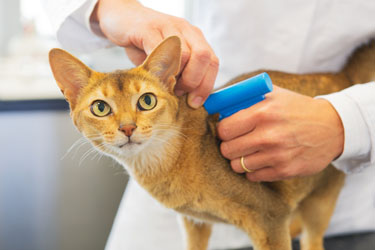Veterinarian Tips: Why Microchip?

When a lost cat or dog is found, most people instantly check for a collar and identification (I.D.) tag. If the information is there, the pet can be on its way back home as soon as the owner is contacted.
Unfortunately, when an animal is lost, they often become separated from their collar and I.D. tags. Without knowing who they belong to, a once-beloved pet may turn into one of the nearly 8 million animals that end up in shelters each year. When an animal is lost, having a microchip will give it the best chance of being reunited with its family.
Check the Chip Day
One way to remind clients of the importance of microchipping their pets is to celebrate Check the Chip Day August 15. You can download a flyer from the American Veterinary Medical Association’s site that offers space for clients to record their pet’s chip number. Visit the website to find more helpful information.
Microchip Facts
The following information provides answers to many of the questions that may be asked when discussing with clients the topic of microchipping pets.
What is a microchip?
A microchip is a very small glass-encased electronic chip that contains an I.D. number specific to an animal. The microchip is implanted just under the animal’s skin.
How does it work?
The microchip works as a transponder, and is made up of a capacitor, antenna and wire. To retrieve the I.D. number, a scanner must be passed over the implanted microchip. The radio waves emitted by the scanner activate the chip which then transmits the information to the scanner and the I.D. number is seen on the scanner’s screen.
Does the microchip track my animal?
No. The microchip does not have GPS tracking abilities. Lacking a battery, the microchip doesn’t contain any other data outside of the specific I.D. information.
What happens after the I.D. number is retrieved?
The information from the microchip links the I.D. number to an online registration site. This information is used to contact the pet-recovery service connected to the microchip. The service will then access the contact information for the microchip’s registered owner to inform them that their pet has been found, as well as where it is being held.
Once my pet is microchipped, is it protected for life?
As long as the microchip information is registered and kept up-to-date, the pet-recovery service should have no difficulty reuniting the client with their lost pet if the animal is brought in and checked for having a microchip. It is recommended to have the veterinarian scan the microchip once a year to ensure it is functioning properly.
In addition, while the microchip I.D. information is available all day and all year, having a microchip does not replace the need for a collar with I.D. tags. Obtaining an animal’s I.D. information off of a microchip requires the use of a scanner, whereas a collar with up-to-date tags may provide immediate access to the owner’s contact information.
Is the microchip implantation considered to be a surgical procedure?
Implanting the microchip is not a surgical procedure, nor does it require the use of anesthesia.
Does microchipping carry any health risks to the animal?
Implantation is completed using a hypodermic needle that is just slightly larger than one used for a regular injection. Since it is an injection that goes under the skin, some inflammation and/or soreness may occur at the site of the implantation.
Since it isn’t a surgical procedure, is it possible for me to microchip my animals?
Even though the procedure is relatively painless, and typically does not cause the animal any undue stress, implanting a microchip should only be done under the supervision of a veterinarian. The success of the microchip requires knowing where and how to place them. Veterinarians are also trained to recognize and treat any potential signs of a problem.
While microchips can last for up to 25 years, clients need to understand that it is their responsibility to inform the pet-recovery service of any changes in their contact information. Missing or incorrect information drastically reduces the chance for being reunited with a lost animal.
Sources:
https://www.avma.org/Events/pethealth/Pages/Check-the-Chip-Day.aspx
https://www.avma.org/Events/pethealth/Documents/CheckTheChipDayFlyer.pdf
https://www.avma.org/KB/Resources/FAQs/Pages/Microchipping-of-animals-FAQ.aspx
Careers
Are you looking for a place to let your talents shine? At Covetrus, we help our practitioner customers better serve their patients and take pride in providing the best customer experience possible. Search our open positions to see our available opportunities.
Newsletter
Stay current with what’s going on with Covetrus, subscribe to receive our newsletter and email communications. Subscribers will receive the latest information in practice management, sales and marketing, animal health, and more.


Leave a comment